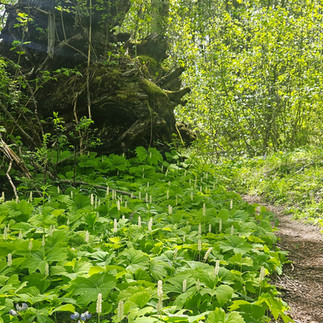Exploring the Botany and Natural Succession of Ecosystems at Coldwater Lake Loop: A Spring Adventure on Loowit
- Krista Lawrence

- May 28, 2024
- 2 min read

This week I thought I would share where I find some of my inspiration. This is a place that a volcano scorched and scoured the earth. It knocked down ancient trees in seconds with its explosive heated ash cloud. The volcano? Her name is Loowit according to indigenous tribes. She was a beautiful maiden once, fought over by two brothers and was changed into a mountain. She was a shapely spire. In 1980 she erupted and created and epic wasteland that has
offered decades of scientific study and data about how ecosystems recover and work through stages of succession. There were theories and then there were the actual observations. For 44 years now.
I have been lucky enough to be able to explore many areas around her and to stand on her summit 4 four times. I feel a true sense of connection with this mountain. Yesterday, I lead a hike for Mazamas .
We had 10 participants eager to learn about the wildflowers, birds, insects, history, and even a little geology. Mostly we were there to focus on the botany and the 11.5 mile hike circumventing Coldwater Lake. The lake was created in the 1980 eruption. Before it was a creek in an older forest. The eruption blocked the outlet of the creek. When looking down onto the lake yesterday you could still see the creek's currents running through the sapphire blue lake. There was a bridge to cross the roaring snowmelt from the Mount Margaret backcountry. the lake looked like a blue jewel with vibrant green ribbons swirling under its surface.
I will note that the birds were amazing on this journey. We saw a spotted sandpiper, our bird expert noted. We used Merlin app by Cornell Labs to make an audio identification with a distant visual
identification. We also utilized a SEEK app associated with the inaturalist app. for some offline botanical identification. Both products were quite effective for observations on this adventure.
Fields of strawberries (Fragia) covered the high eastern ridge we climbed in the cool and cloudy morning. We could only glimpse pieces of Loowit's west flank as we ascended the 1000 foot ridge. We wove in and out of alder groves dripping with candy flower (Claytonia), Trilliums,, Corydalis, Viola, bleeding hearts (Dicentra), Cohosh (Actaea rubra) and inside out flower (Vancouveria). on the open were masses of Lupinus and Paintbrush (Castejilla). The evergreen huckleberries (Vaccinium ovatum) were bronzed with new growth. Some in the group took notice that the color was as vibrant as fall foliage. The Willows were creating a fairy wonderland with their fluffy cotton dancing in the subtle breeze as we descended into the lake valley around 1pm. We followed our excellent navigator to an open beach on the lake and ate a well deserved lunch with our boots off grounding in the sunshine. As we walked out along the west side of the lake, the team popped in and out of alder groves into open sunny meadows, crossed streams and waterfalls spilling from the steep west ridge, and gazed at distant snow dusted Cascade peaks west of Loowit across the vibrant mountain lake. It was a fantastic day!




















































Comments